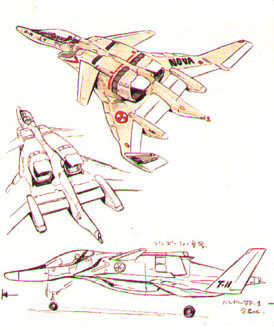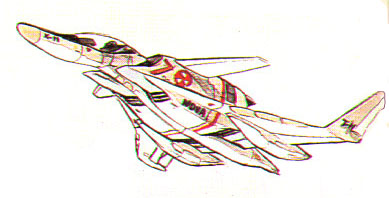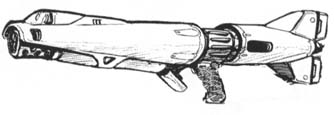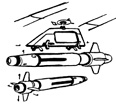XVF-10 "Apache" Veritech Fighter
(Version 1.01 - Last updated: 10/14/02)
- Background and RPG Statistics by Kenneth
Olson
- Background Information
derived from Robotech Technical
Files
BACKGROUND
 In late 2023, the Robotech Defense Force
(RDF) was in desperate need of a new generation of veritech fighter to replace
the aging VF-1 series which populated a majority of their forces. By 2023
nearly 80% of the variable fighter squadrons of the RDF were based of the VF-1
Valkyrie, a design which was nearly 15 years old; although RDF did possess a
limited number of VF-6 fighters. Project Nova began in July of that year
with the purpose to
create a new fighter for which both the RDF and the Armies of the Southern Cross
(ASC) could use. A fighter such designed would be produced in quantity and
the price per unit could be reduced.
In late 2023, the Robotech Defense Force
(RDF) was in desperate need of a new generation of veritech fighter to replace
the aging VF-1 series which populated a majority of their forces. By 2023
nearly 80% of the variable fighter squadrons of the RDF were based of the VF-1
Valkyrie, a design which was nearly 15 years old; although RDF did possess a
limited number of VF-6 fighters. Project Nova began in July of that year
with the purpose to
create a new fighter for which both the RDF and the Armies of the Southern Cross
(ASC) could use. A fighter such designed would be produced in quantity and
the price per unit could be reduced.
Several designs were submitted, however one of the most
promising was the XVF-10 "Apache" from the Robotech Research facilities located
in Tokyo Japan. This new veritech would be based on a similar airframe and
internal structure to the VF-4 "Lightning"; however it
could be manufactured at a fraction of the cost. Apache would only possess
ammunition based weaponry and would not have any of the costly EP-4 particle
beam cannons and associated protoculture generators of the earlier VF-4 An
ammunition based veritech was not felt to be a hindrance. The XVF-10
was designed to fight rogue Zentraedi forces and possessed sufficient
atmospheric and space maneuverability to out fly any of the traditional
Zentraedi threats. This coupled with a large externally mounted missile
load, up to 60 short range hammer head missiles, the Apache could fire its
missiles at long range, destroying a large number of the incoming fighters and
close to gun range to dispatch the survivors or escape to fight another day or
close on the .
The Armies of the Southern Cross, upon examination of the first
experimental fighter in January of 2024, decided to pull out of the research and
began production on their own transforming fighter, the
VF-8 Logan. Undaunted by the
pullout, the RDF continued research on the Apache for two more years producing a total of
125 fighters. Eventually, pressure issued by the Southern Cross and promises of
large quantities of ASC built veritechs, forced the RDF to abandon the XVF-10 project in
November 2027.
The few Apache veritechs built were scattered around the earth at various
outposts at the beginning of the Second Robotech War. The XVF-10 saw some
limited combat
action; however the fighter proved completely unsuited for fighting against the Robotech
Masters. The Apache's missiles were not capable of taking down the larger and more
powerful Assault Carriers and the mecha was completely unsuited for the stand and deliver
tactics of the bioroids. Several Apaches survived the Second Robotech War and were
used by resistant groups in North America and Europe fighting against the Invid
domination; however, none of these are known to have survived.
RPG STATS
- Vehicle Type: XVF-10 "Apache"
- Class: Experimental Variable Fighter
Manufacturer: Robotech Defense Forces
Crew: One pilot wearing Tactical Life Support System.
MDC BY LOCATION:
| Location |
Apache |
| (1) Head |
75 |
| Hands (2) |
30 |
| Arms (2) |
125 |
| Legs/Engine Thrusters |
200 |
| (2) Main Body |
250 |
| Reinforced Pilots Compartment |
175 |
| Retractable Utility Arms |
3 |
| Wings (2) |
150 |
| Tails (2) |
50 |
| Canards (2) |
50 |
| GU-111 |
100 |
NOTES:
- Destroying the sensor head of the Apache will knock out the mecha's major sensor
systems, including all of the optics systems (infrared, nightvision, thermal). Radar and
communications will be unaffected.
- Depleting the MDC of the main body will destroy the mecha.
SPEEDS:
- RUNNING, SOLDIER CONFIGURATION:
- 150 kph
- LEAPING, SOLDIER CONFIGURATION:
- 50 ft (15 m) high or 70 ft (21 m) long without thrusters.
- FLYING, SOLDIER CONFIGURATION:
- 320 kph / 400 kph for (A,B,G,H,I,T)
- FLYING, GERWALK/SOLDIER CONFIGURATION:
- Mach One (670 mph/1072 kmph) maximum speed limit in an Earth-like atmosphere. Can also
hover in place indefinitely.
- FLYING, FIGHTER CONFIGURATION:
- Max level speed at sea level : Mach 1.4
Max level speed at 10km: Mach 4.2
Max level speed at 30+ km: Mach 9.0
- Stall speed : 182 kph (VTOL rectification possible)
Initial climb rate : over 35000m per minute
Service ceiling : 40 km (unboosted).
- DESIGNED G LIMITS:
- +12.0/-6.5 (Computer overrides at 9.5g)
- MAX ACCELERATION: SPACE
- 5.2 g
- DELTA V:
- 15.4 kps with 7000 kg of D20
- Drop Tanks will provide an additional delta v of:
- 1300 liters - 2.3 kps
- 2310 liters - 4.0 kps
- 4000 liters - 6.7 kps
-
 STATISTICAL DATA:
STATISTICAL DATA:
- HEIGHT:
- 14.7m in soldier configuration.
- 10.7m in gerwalk configuration.
- 5.7m in fighter configuration.
- WIDTH:
- 9.1m at shoulders in soldier and gerwalk configuration.
- 16.8m with wings at maximum extension.
- LENGTH:
- 4.8m in soldier configuration.
- 10.3m in gerwalk configuration.
- 12.0m in fighter configuration.
- WEIGHT:
- 15,000 kg empty.
- PHYSICAL STRENGTH:
- Equal to a P.S. of 60
- CARGO:
- Small compartment behind pilot's seat for personal belongings in addition to the cyclone
storage compartment
- POWER PLANT:
- One Tirolian mecha protoculture-generators RT/PS-4d providing a total of 325 MW
- MAX ENGINE THRUST
- [MAIN] 2 X Nakajima/P&W/Rolls-Royce FF-2015 fusion turbines,
Max thrust, 350 kN of static thrust (450 kN
augmented) in the atmosphere or 300 kN using internal reaction mass in space
(specific impulse of 4100 sec). Exhaust
nozzles allow for vector thrust, serving in place of conventional elevators. System
includes two reverse-vernier thrusters, on blisters outboard of each intake; exhaust comes
directly from main turbine at a maximum of 20% thrust.
- [Auxiliary] 4 x Nakajima HMM-1A high-thrust vernier thrusters:
Miniaturized fusion plasma-air/reaction mass intermix ramjets Each
engine is rated to 41.3 kN
- FUEL CAPACITY:
- 7000 liters of D20 for reaction mass
- COMPATIBLE FAST PACKS:
- None
WEAPON SYSTEMS:

- GU-111 65MM THREE-BARRELED SMOOTHBORE
ROTARY: firing 700 rounds per minute, 600 round capacity stored internally.
- PRIMARY PURPOSE: Assault
- SECONDARY PURPOSE: Anti-Mecha
- RANGE: Armor Piercing Spin Stablized Discarding Sabot (APSSDS) 5249 feet (1600
m), or 3937ft (1200m) for all others.
- DAMAGE: APSSDS 6d6 short burst, 1d4*10+10 medium burst, 3d4*10+10 full melee
burst. HEAP 1d4*10 short burst, 2d4*10 medium burst, 4d4*10 full melee burst.
Tracer rounds reduce damage by 25%. Standard 5d6 short burst, 1d4*10 medium burst,
or 3d4*10 full melee burst
- RATE OF FIRE: Single shots or bursts equal to the combined attacks of the pilot.
- PAYLOAD: 600 rounds of internal ammunition or 60 short bursts, 30 medium, or 15
full melee.
- NOTES: APSSDS crits on 17,18,19,20. HEAP crits on 19,20.
Tracers add +2 to strike.
-
 4
x BODY/WING HARD POINTS: Two fixed hard points are mounted on each wing.
Each of thes hardpoints can carry 15 short range missiles, 3 medium, 2 long
range (one on the inner hardpoint), or a single CBM-200 Anti-mecha CLUSTER BOMB.
4
x BODY/WING HARD POINTS: Two fixed hard points are mounted on each wing.
Each of thes hardpoints can carry 15 short range missiles, 3 medium, 2 long
range (one on the inner hardpoint), or a single CBM-200 Anti-mecha CLUSTER BOMB.
- HAND TO HAND COMBAT: If necessary, the Apache can engage in melee combat rather
than use a weapon. The XVF-10 is extremely agile and can execute most typical hand
to hand combat moves, such as punches, jump kicks, leap attacks, rolling with impacts,
etc.
DAMAGE:
- Punch in Battloid: 3D6*3
- Punch in Guardian: 3D4*3
- Kick: 3D6*3
- Leap Kick: 6D6*3
- Body Flip/Throw: 3D6*3
- Body Block/Tackle: 3D6*3
- Stomp: 6D6*3 . (only effective against small objects)
STANDARD EQUIPMENT FOR THE APACHE:
- ACTIVE SENSOR JAMMER
WESTINGHOUSE ALQ-250(V): internal ECM providing broadband protection.
Estimated system effective radiative power 50 dBW.
- AUTO-PILOT: The Apache is equipped with a computerized auto-pilot, allowing the
pilot to relax or even sleep during long voyages. The auto- pilot can be programmed with a
single destination or a complex flight plan involving multiple speeds, directions, and
destinations. The onboard computer will alert the pilot when the fighter is near its
destination, and can also be set to automatically signal when sensors detect objects near
the mecha. The auto-pilot was designed with long intra-system space journeys in mind.
- CHAFF AND FLARE DISPENSERS: 30 chaff and 30 flares are stored in
each of the
lower legs
- COMBAT COMPUTER: The combat computer tracks and identifies specific enemy
targets, and has a database of over 10,000 images stored in memory. The computer can
identify and track up to 250 targets simultaneously.
- EXTERNAL AUDIO PICKUP: Range: 300 ft (91.5 m). A sound amplification system that
can pick up normal conversation up to 300 feet away.
- INFRA-RED WARNING RECEIVER OLDELFT (IRWR):
Providing rear aspect protection from IR guided missiles
- HEAT AND RADIATION SHIELDS: Special shielding prevents the penetration of life
threatening head and radiation. A radiation detection and alarm system are linked with the
shields and will sound an alarm if there is a rupture in the shields and what the levels
of radiation are.
- HOMING SIGNAL: The escape pod of the XVF-10 is equipped with a homing
device that enables rescue teams to locate a disabled craft or ejected life pod. The range
of the signal is 400 miles (640 km). Most REF ships and veritecs can locate and track a
homing signal, and the onboard computers will automatically notify their pilots if such a
signal is detected.
- LASER TARGETING SYSTEM: Range: 100 miles (160 km). Used for increased accuracy in
the striking of enemy targets and is partly responsible for the mecha's strike bonus.
- LOUDSPEAKER: A loudspeaker system is built into the craft, which can be used to
amplify the pilot's voice up to 90 decibels.
- OPTICS: INFRARED: Range: 2000 feet (610 m). This optical system projects a beam
of infrared light that is invisible to the normal eye, but detectable by the mecha's
sensors. The system allows the pilot to detect hidden/concealed objects by their IR
reflectiveness. The beam will be visible to anyone with IR sensitive optics, however.
- OPTICS: NIGHTVISION: Range: 2000 feet (610 m). A passive light image intensifier
that emits no light of its own, but relies on ambient light which is electronically
amplified to produce a visible picture.
- OPTICS: THERMAL IMAGER: Range: 2000 feet (610 m). A passive optical heat sensor
that detects infrared radiation projected by warm objects and converts that data into a
false-color visible image. The system enables the pilot to see in the dark, in shadows,
and through smoke, and also adds a +10% bonus to pilots using a tracking skill.
- RADAR: 200 mile range.
- RADIO/VIDEO COMMUNICATION: Long range, directional communications system with
satellite relay capabilities. Range: 600 miles (960 km) or can be boosted indefinitely via
satellite relay.
- RADAR WARNING RECEIVER (RWR): The Apache mounts a
Elettronica RWR providing all
aspect broadband protection from RF guided missiles.
- SELF-DESTRUCT: To prevent capture of an advance variable fighter by the enemy,
the pilot can activate the XVF-10 self-destruct system, which will cause the fighter
to explode after a delay of up to 60 minutes (time is set by the pilot). The explosive
damage is contained within a 20 foot (6 m) area and inflicts 1D6x10 M.D. to everything
within the radius of the explosion. All internal systems are obliterated. The escape pod
will be automatically ejected prior to the explosion unless the pilot overrides the
ejection sequence.
- STANDARD SURVIVAL KIT: All RDF veritecs come equipped with a portable survival
kit. Inside the small reinforced box is a medium-sized flashlight, two hand flares, one
rocket flare, a compass, infrared distancing binoculars, a small mirror, a pocket knife,
dehydrated and concentrated food (can be stretched into a five day supply for one person)
and basic first aid items (aspirin, bandages, disinfectants, etc.)
- TACTICAL LIFE SUPPORT SYSTEM: The XVF-10 cockpit is pressurized, and also
provides additional air feeds to the pilot's flight suit that provides him with
pressurized breathing. The REF flight suit also contains an upper and lower g-suit that
promotes blood circulation even during high-g turns, thus decreasing the possibility of
pilot's blacking out in combat.
COMBAT BONUSES FOR XVF-10 TRAINING:
- 3 attacks per melee (plus those of the pilot).
- Add one additional action/attack at levels six and eleven.
- +1 to strike
- +2 to parry
- +2 to dodge in solder, +4 in guardian, and +6 in jet mode.
- +3 to roll with a punch or fall with an impact, reducing damage by half.
- Critical strike same as pilot's hand-to-hand.
REFERENCES USED IN THIS DESIGN
- Robotech Technical Files: Veritech Valkyrie
- Palladium Books: "Robotech The Roll Playing Game"
Back to Mecha Home
 In late 2023, the Robotech Defense Force
(RDF) was in desperate need of a new generation of veritech fighter to replace
the aging VF-1 series which populated a majority of their forces. By 2023
nearly 80% of the variable fighter squadrons of the RDF were based of the VF-1
Valkyrie, a design which was nearly 15 years old; although RDF did possess a
limited number of VF-6 fighters. Project Nova began in July of that year
with the purpose to
create a new fighter for which both the RDF and the Armies of the Southern Cross
(ASC) could use. A fighter such designed would be produced in quantity and
the price per unit could be reduced.
In late 2023, the Robotech Defense Force
(RDF) was in desperate need of a new generation of veritech fighter to replace
the aging VF-1 series which populated a majority of their forces. By 2023
nearly 80% of the variable fighter squadrons of the RDF were based of the VF-1
Valkyrie, a design which was nearly 15 years old; although RDF did possess a
limited number of VF-6 fighters. Project Nova began in July of that year
with the purpose to
create a new fighter for which both the RDF and the Armies of the Southern Cross
(ASC) could use. A fighter such designed would be produced in quantity and
the price per unit could be reduced.  STATISTICAL DATA:
STATISTICAL DATA:
 4
x BODY/WING HARD POINTS: Two fixed hard points are mounted on each wing.
Each of thes hardpoints can carry 15 short range missiles, 3 medium, 2 long
range (one on the inner hardpoint), or a single
4
x BODY/WING HARD POINTS: Two fixed hard points are mounted on each wing.
Each of thes hardpoints can carry 15 short range missiles, 3 medium, 2 long
range (one on the inner hardpoint), or a single